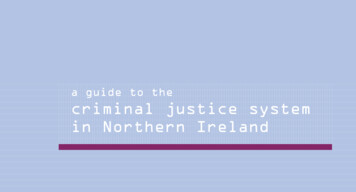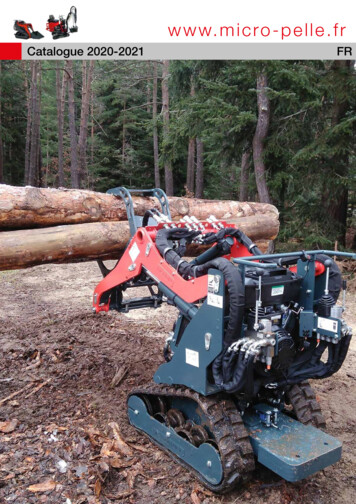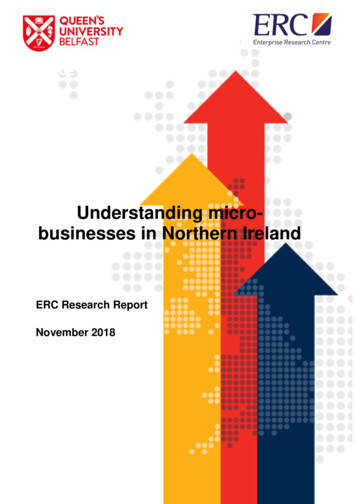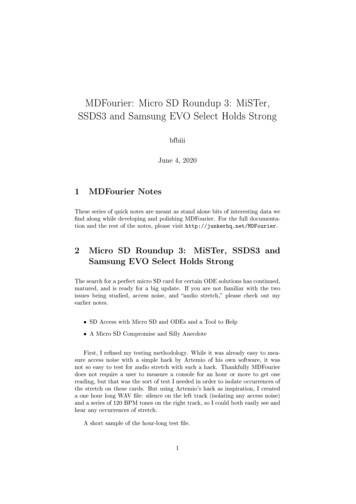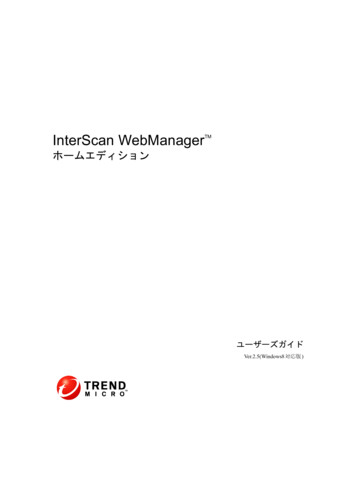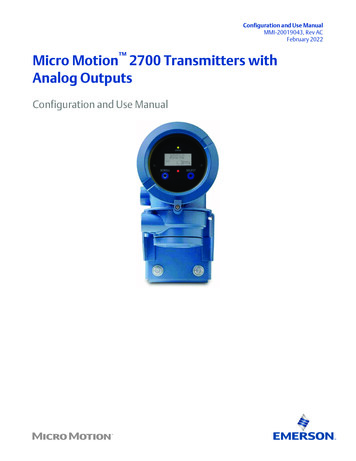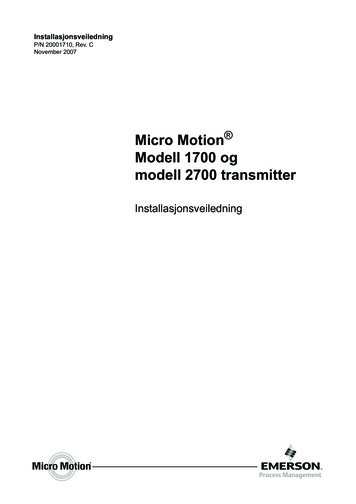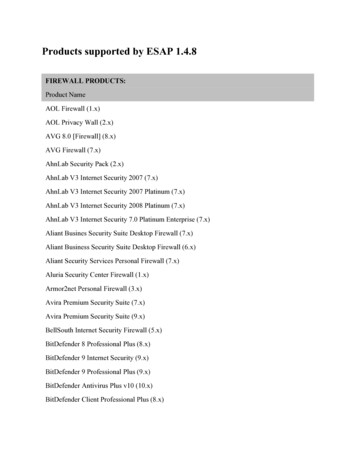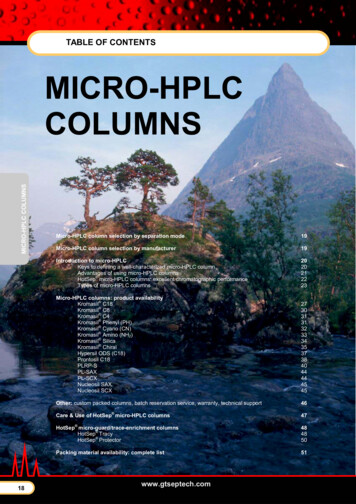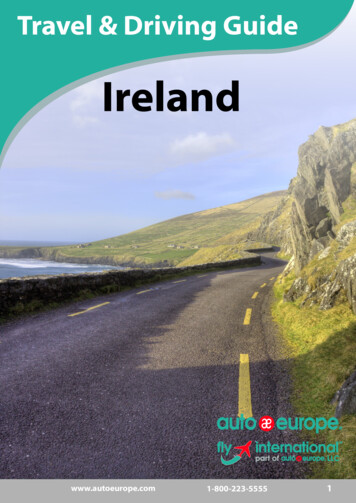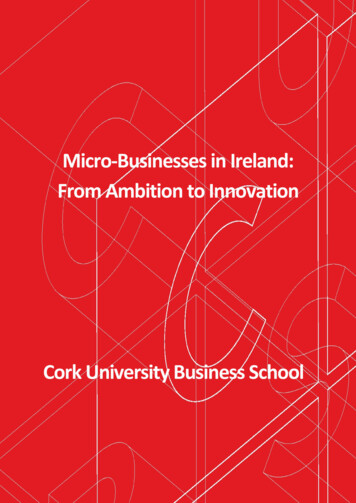
Transcription
Micro-Businesses in Ireland:From Ambition to InnovationCork University Business School
Micro-Businesses in Ireland:From Ambition to InnovationApril 2019Dr. Jane Bourke and Prof. Stephen RoperDr. Jane Bourke is a Senior Lecturer in Economics at University College Cork. Herresearch interests include Innovation, Technology Adoption, Business Performance,and Health Economics. Jane is a co-investigator and senior researcher at the EnterpriseResearch Centre. She is a founding member and theme leader (Innovation Systems)at the Spatial and Regional Economics Research Centre at UCC. Jane has published herwork in internationally recognised peer-reviewed journals such as Research Policy,Technovation, and International Journal of Innovation Management.Professor Stephen Roper is Director of the Enterprise Research Centre and Professorof Enterprise at Warwick Business School (WBS). His research interests includeinnovation, enterprise growth and development, regional development, and industrialpolicy evaluation. Stephen has led over 50 externally funded research projects, ran hisown consultancy company for some years, and works regularly with OECD onconsultancy assignments relating to small business policy and evaluation. He has alsoconsulted for a range of other private sector and policy organisations.
ABOUT THIS REPORTThis report represents a collaboration between University College Cork and the UK EnterpriseResearch Centre. Views in the report are those of the authors alone and do not necessarilyreflect those of the sponsoring organisations.SPATIAL AND REGIONAL ECONOMICS RESEARCH CENTREThe Spatial and Regional Economics Research Centre (SRERC) was launched in 2018 and arisesfrom the extensive experience and research expertise in regional science developed by acluster of staff in the Department of Economics, University College Cork. The Centre operateson the philosophy of research excellence and policy relevance. The Centre focuses on threecentral themes: Spatial Economic Analysis; Innovation Systems; and Urban and RegionalEconomics. Members of the SRERC have been engaged in consultancy and research fundedby the European Commission, Environmental Planning Agency, the UK Economic and SocialResearch Council, Science Foundation Ireland, the Irish Research Council, Forfás, EnterpriseIreland, Irish Regional Assemblies and and city and county councils, among others.ENTERPRISE RESEARCH CENTREThe Enterprise Research Centre is an independent research centre which focusses on SMEgrowth and productivity. ERC is a partnership between Warwick Business School, AstonBusiness School, Queen’s University School of Management, Leeds University Business Schooland University College Cork. The Centre is funded by the Economic and Social ResearchCouncil (ESRC); Department for Business, Energy & Industrial Strategy (BEIS); Innovate UK, theBritish Business Bank and the UK Intellectual Property Office.ACKNOWLEDGEMENTThe authors are pleased to acknowledge financial support from the Economic and SocialResearch Council for the survey on which this report is based. Katherine Hathaway and MarkHart (Aston and ERC) made important contributions to the success of the survey fieldwork.Justin Doran (UCC and SRERC) provided valuable assistance in compiling geographical maps.We would also like to thank all the micro-businesses who kindly completed our survey.Cite this report as: Bourke, J. and S. Roper (2019). Micro-Businesses in Ireland: From Ambitionto Innovation. Cork: Cork University Business School, University College Cork.
FOREWORDI am delighted to introduce this important report, conducted by my colleagues in CorkUniversity Business School in collaboration with the Enterprise Research Centre in the UK.This report presents new information on the ambitions, growth aspirations and innovationlevels of Irish micro-businesses.Micro businesses, typically businesses with 9 employees or less, play an important role instimulating innovation, employment and growth. Despite this, relatively little is known aboutthis important segment of the business population as such businesses are often excludedfrom official surveys. This report presents the findings of a survey conducted on microbusinesses in Ireland.Ambition plays an important role in ensuring businesses achieve their full potential. Thesurvey conducted during the course of this project reveals that one in four micro-businessesin Ireland want to build a national or international business. Within Ireland, micro-businessesin the West are amongst the most ambitious nationally. Interestingly, however, business andpersonal ambitions are broadly similar for male and female micro-businesses owners. Formany people flexibility is a key personal motivator for running their own micro-business.This report provides the first detailed information on the uptake of digital technologies bymicro-businesses in Ireland. The results suggest that Irish micro-businesses perform well,adopting digital technology at a faster rate than their counterparts in the UK and particularlythe USA. Micro-businesses in Ireland also compare well internationally with respect tointroducing new or improved products and services. Finally, the report emphasises theimportance that micro-businesses, due to their scale and access to technology, should not beleft behind larger businesses in the global digital revolution.Professor Thia HennessyDean, Cork University Business Schooli
TABLE OF CONTENTSFOREWORD. iEXECUTIVE SUMMARY . 21.Introduction . 42. Understanding Micro-businesses in Ireland . 53. A Story of Ambition – for the business, for the individual .63.1 Profile of Ambition in Micro-Businesses in Ireland . 63.2 The Geography of Ambition in Ireland . 93.3 Gender Differentials in Ambition Profiles . 164. Innovation. 194.1 New products or services and new forms of organisation . 194.2 Innovation Success . 225. Digital Technology: Adoption and Diffusion .255.1 Digital Technology Adoption in Ireland . 265.2 Diffusion of Digital Technology since 2012 . 28Appendix 1: Sectoral Overview of Survey Data . 29Appendix 2: Regional Breakdown of Technology Adoption. 30Endnotes . 341
EXECUTIVE SUMMARYThis report describes new and unique survey data on established micro-businesses with 1-9employees in Ireland. The report focuses on the ambitions – business and personal- of theowners; as well as innovative activity and the uptake of digital technology within microbusinesses.In Ireland, most micro-businesses are mature, and many are home-based. They are closelyrelated to the families which own and run them.A Story of Ambition – for the business, for the individual An ambitious 27 per cent of micro-business in Ireland want to build a national orinternational business, while 71 per cent of micro-businesses emphasise theimportance of keeping their business similar to how it operates now. Over 80 per cent of micro-business owners report ‘freedom to adapt my ownapproach to work’ and ‘greater flexibility for personal and family life’ as key personalmotivators. Micro-businesses in the West (Galway & Galway City, Mayo & Roscommon) areamongst the most ambitious in the country. Micro-businesses in the Border region (Cavan, Donegal, Leitrim, Monaghan, Sligo)reveal a low ambition profile. One-third of micro-businesses in Dublin consider growth to be an important ambition.However, micro-businesses based in Dublin are not markedly more ambitious thanmicro-businesses across the country. In the South-East (Carlow, Kilkenny, Wexford, Waterford & Waterford City), microbusiness owners are more likely to emphasise personal rather than businessambitions. Profiles of ambition for male and female business owners are largely similar.2
Innovation - new products, new services, new ways of doing things Levels of innovation in Irish micro-businesses in Ireland are higher than those in theUK and USA. 40 per cent of micro-businesses introduced a new or improved product or service inthe three years prior to the survey. One in four micro-businesses introduced new business models or forms oforganisation in the three years prior to the survey. The percentage of sales derived from innovative products and/or services isapproximately 11 per cent.Uptake of Digital Technology: Trends & Patterns From a relatively low base in 2012, diffusion of digital technologies by microbusinesses in Ireland is strong and growing. Uptake of digital technologies by micro-businesses in Ireland compares well withthose in the UK and is considerably higher than those in the USA. The most popular digital technologies among micro-businesses in Ireland are CloudComputing and Web-based Accounting Software, with 40 per cent of micro-firmsusing these technologies. 34 per cent of micro-businesses in Ireland are using E-Commerce, while 26 per centand 17 per cent are using Computer-Aided Design (CAD) and Customer RelationshipManagement (CRM) respectively. There is little variation in the average number of technologies adopted by microbusinesses across the regions of Ireland. However, approximately one in four micro-businesses have not adopted any digitaltechnology.3
1. IntroductionIn Ireland, micro-businesses with less than 10 employees comprise over 90 per cent ofbusinesses.i These firms are critical to future productivity and job growth. However, we knowlittle about micro-businesses as they are often excluded from national and internationalsurveys. ii Using new survey data, this report describes this diverse segment of the SMEpopulation in Ireland, focusing on business and personal ambition, innovation and digitaltechnology adoption.There are a quarter of a million micro-businesses in Ireland, employing almost 400,000people.iii These businesses play an important role in all of our lives. They are our plumbers,our builders, our hairdressers and our mechanics. They are also our architects, designers,artists, lawyers and accountants. Most micro-businesses start small and stay small. For otherentrepreneurs their micro-business is the launchpad for scale-up. Or, at least, the test-bed fora new business idea or innovation.The purpose of this survey-based project is to study the ambitions, growth aspirations andlevels of innovation among established micro-businesses in Ireland, the UK, and the USA, andto help us understand what drives their growth and productivity. iv Data was collected from1,500 micro-businesses over three years old in Ireland between January and March 2018, aswell as 6,200 in the UK and 2000 in the US. Like all survey analyses, results have a smallsampling error; therefore, responses are weighted to give representative results.Section 2 briefly profiles micro-businesses in Ireland. Section 3 looks at the business andpersonal ambitions of micro-business owners in Ireland at national and regional levels, as wellas looking at gender differences. Section 4 describes innovation metrics for micro-businessesin Ireland. Section 5 focuses on the uptake of digital technology by micro-businesses in Ireland.4
2. Understanding Micro-businesses in IrelandA brief description of established micro-businesses (i.e. more than three years old) in Irelandis provided below. On average micro-businesses in Ireland have 3.1 employees and have been operatingfor 24.7 years. The ratio of male to female owners is approximately 2:1. Around half (47.3 per cent) of all micro-businesses in Ireland are home-based, while77 per cent of micro-businesses in Ireland are family-owned. Typically, the founder is not the only member of the firms’ leadership team. Onaverage, the size of the leadership team is 1.8. Approximately 85 per cent of micro-businesses in Ireland traded profitably over theperiod 2017-8. 45 per cent of micro-businesses reported an increase in turnover from the previous12 months, while 10 per cent reported a decline in turnover. 45 per cent reported thattheir turnover had remained the same as the previous 12 months. 41 per cent of micro-businesses export their goods and/or services to internationalmarkets. The average percentage of sales derived from international markets is 12 percent. In Ireland, 47 per cent of micro-businesses use external finance from banks or otherlenders. This is considerably higher than the UK and USA. Less than 5 per cent ofmicro-businesses access funding from family & friends. Almost one in five microbusinesses have sought additional finance over the last year.5
3. A Story of Ambition – for the business, for the individual3.1 Profile of Ambition in Micro-Businesses in IrelandPrevious research has linked owner-managers’ growth ambitions to the subsequent growthand performance of the firm.v In this survey, we use a new set of ambition questions whichreflect individuals’ aspirations for their own future and their aspirations for the future oftheir business. In the Dutch Growth Accelerator programme, for example, attendees areasked to reflect on their own individual aspirations for the future and separately on theiraspirations for the future of their businessvi. Given the nature of micro-businesses these twosets of aspirations are often strongly interlinked but for many owner-managers theiraspirations for the business will be a means towards a more personal ambition.Figure 3.1: Indicators of business ambition28.827.422.1Build a national and/or international business77.270.973.7Keep business similar to how it operates nowGrow business with a view to exit30.9Develop more professional HR practices23.051.939.733.030.848.4Develop culture of employee engagement57.553.546.6Increase social and environmental benefits47.50102030405055.360708090100Percenage of Business OwnersUSAIrelandUKLooking first at respondents’ aspirations for their micro-business we consider the proportionof respondents ranking each aspiration as ‘important’ or ‘very important’. There is a sharp6
distinction between 71 per cent of Irish respondents’ who aim to ‘keep their business similarto how it operates now’, and a more ambitious 27 per cent who aim to build a ‘national orinternational business’ (Figure 3.1). Other more operational aspirations – employeeengagement, HR practices, social benefits - fall between these two extremes with 57.5 percent of all micro-business owners in Ireland aiming ‘to create a culture of employeeengagement’ and 55 per cent aiming ‘to increase the social and environmental benefits of thebusiness (Figure 3.1).Overall, the profiles of business ambition are broadly similar in Ireland and the UK, and alittle lower than their micro-business owner counterparts in the USA. For instance, theproportion of firms which aim to ‘grow rapidly with a view to exit’ differs significantly acrossthese regions; 58 per cent in the US compared to 40 per cent in Ireland and 31 per cent inthe UK (Figure 3.1).Individuals’ personal ambitions suggest a rather different set of priorities, with a markedemphasis on ‘freedom’ and ‘flexibility’ (Figure 3.2). Over 80 per cent of micro-business ownersin Ireland aim ‘to have considerable freedom to adapt my own approach to work’ and ‘to havegreater flexibility for my personal and family life’. This is consistent with much of the researchliterature on self-employment and entrepreneurship which stresses the financial as well asthe non-financial benefits of being your own boss.7
Figure 3.2: Indicators of personal ambitionGreater flexibility for personal & family life87.285.581.1Freedom to adapt own approach to work87.782.581.1Build great wealth or high income62.743.341.354.349.444.4Become successful business leader44.747.942.2Build business to hand on to familyTo be able to retire64.864.401020304050607075.68090100Percentage of Business OwnersUSAIrelandUKIn terms of personal ambition, 65 per cent of micro-business owners in Ireland want ‘to beable to retire’, while almost half of micro-business owners want ‘to build a business I canhand on to my family’ and ‘to fulfil a personal vision of becoming a successful businessleader in the community’. Interestingly, only 43 per cent want ‘to have a chance to buildgreat wealth or a very high income’. This is in marked contrast to the USA where this figureis 63 per cent. In general, Irish micro-businesses owners profess similar personal ambitionsto their counterparts in the UK.8
3.2 The Geography of Ambition in IrelandNow we consider the regional differences in business and personal ambition among microbusinesses in Ireland. Our regional analysis uses the Nomenclature of Territorial Units forStatistics (NUTS3) for Ireland.vii Due to sample size restrictions, we have combined the MidEast and Midlands regions. The shape of ambition – business and personal – for microbusinesses varies across Ireland. We use radar charts to illustrate these regional variations.DESCRIPTION: Radar Ambition ChartsOur radar charts illustrate therange of ambition indicators atthe regional level.The orange line is an indicatorof the highest level of ambitionrecorded for each of thebusiness and personal ambitionmeasures at the regional level,and the blue line is an indicatorof the lowest level of ambitionrecorded.For instance, the extent to which micro- businesses across the regions consider theambition ‘to build a business to hand on to family’ to be important ranges from 40 per cent(blue line) to 60 per cent (orange line) approximately. While the social and environmentalelements of the business are important to between 40 and 70 per cent of microbusinesses. Highest and lowest indicators of ambition are constant all the radar chartsThe black lines in the radar charts illustrate how each region compares across thesebusiness and personal ambitions. The closer the black line (region) is to the orange line(highest level of ambition), the more ambitious that region is relative to other regions withrespect to that particular ambition measure. Similarly, when the black line is close to theblue line (lowest level of ambition), this reflects low levels of ambition for that particularambition indicator in micro-businesses in that region.9
Figure 3.3. allows us to compare the ambition profile of micro-businesses in Dublin with therest of the country. We can see that micro-businesses in Dublin are at the upper end of theambition scale with respect to growing their business and the personal ambitions offlexibility and freedom. However, their ambition profile is low with regard to building abusiness to hand on to family, being able to retire, accumulating great wealth and beingconsidered a business leader in the community.Figure 3.3: Ambition in Micro-businesses: DublinAble to RetireBuild business forfamilyGrowth Ambition9080706050403020100Business LeaderExit AmbitionWorkplace CultureSocial & EnvironmentGreat WealthFlexibilityLowestHighestFreedomDublin10
Figure 3.4 shows that micro-businesses in the West are amongst the most ambitious in thecountry. The West is consistently the most ambitious region across business and personalambition indicators. For instance, micro-businesses in the West are more likely to considerworkplace culture and social and environmental elements of the business to be importantmotivations than micro-businesses in other regions. Interestingly, Figure 3.4 reveals thatalmost 80 per cent of micro-businesses in the West consider building their business with aview to exit as being important. This is significantly higher than all other regions in Ireland,including Dublin where the corresponding figure is approximately 45 per cent.Figure 3.4: Ambition in Micro-businesses: WestAble to RetireBuild business forfamilyGrowth Ambition9080706050403020100Business LeaderExit AmbitionWorkplace CultureSocial & EnvironmentGreat WealthFlexibilityLowestHighestWestFreedom11
This contrasts with micro-businesses in the Border region (see Figure 3.5) which reveal aprofile of lower ambition, for both business and personal indicators. Micro-businesses in theBorder region are less likely to be motivated by growth, great wealth and being a businessleader in their community than micro-businesses in other parts of the country.Figure 3.5: Ambition in Micro-businesses: BorderAble to RetireBuild business forfamilyGrowth Ambition9080706050403020100Business LeaderExit AmbitionWorkplace CultureSocial & EnvironmentGreat WealthFlexibilityLowestHighestFreedomBorder12
There are interesting contrasts between business and personal ambitions amongst microbusinesses in the South-East (see Figure 3.6). Micro-businesses owners in the South-East areat the lower end of the scale for business ambitions such as growth, view to exit, workplaceculture and social and environmental elements. However, micro-businesses in the SouthEast reveal high personal ambitions compared to other regions. They are at the upper endof the scale regarding flexibility, accumulating great wealth, building a business to hand onto family, being able to retire and being considered a successful business leader in thecommunity as being important motivators.Figure 3.6: Ambition in Micro-businesses: South-EastAble to RetireBuild business forfamilyGrowth Ambition9080706050403020100Business LeaderExit AmbitionWorkplace CultureSocial & EnvironmentGreat WealthFlexibilityLowestFreedomHighestSouth-East13
Owners of micro-businesses in the South-West (see Figure 3.7) do not appear to beparticularly motivated by business ambitions, but do consider accumulating great wealth asa higher priority than micro-businesses in other regions.Figure 3.7: Ambition in Micro-businesses: South-WestAble to RetireBuild business forfamilyGrowth Ambition9080706050403020100Business LeaderExit AmbitionWorkplace CultureSocial & EnvironmentGreat WealthFlexibilityLowestFreedomHighestSouth-West14
Similarly, business ambitions tend to be relatively low in the Mid-East and Midlands (Figure3.8) relative to other regions. As across all regions, ‘flexibility’ and ‘freedom’ are importantpersonal aspirations for micro-business owners in the Mid-East & Midlands.Figure 3.8: Ambition in Micro-businesses: Mid-East & MidlandsAble to RetireBuild business forfamilyGrowth Ambition9080706050403020100Exit AmbitionWorkplace CultureSocial &EnvironmentBusiness LeaderGreat WealthFlexibilityLowestFreedomHighestMid-East & MidlandsMicro-businesses in the Mid-West reveal a moderate ambition profile relative to otherregions (Figure 3.9). Business ambitions around growth and exit strategies are low, withfreedom to adapt their own approach to work and being able to retire being moreimportant.15
Figure 3.9: Ambition in Micro-businesses: Mid-WestAble to RetireBuild business forfamilyGrowth Ambition9080706050403020100Business LeaderExit AmbitionWorkplace CultureSocial & EnvironmentGreat WealthFlexibilityLowestFreedomHighestMid-West3.3 Gender Differentials in Ambition ProfilesWe see very similar profiles of business and personal objectives for male and female microbusiness owners (Figures 3.10 and 3.11), albeit with some male-female distinctions in termsof the importance placed on business versus personal ambitions.Firstly, looking at business ambitions, over two-thirds of male and female business ownersemphasise their desire to keep the business similar to how it operates now (Figure 3.10).However, slightly more male business owners report higher growth ambitions with respectto building a national and/or international business than their female counterparts.In addition, male business owners are more likely to aspire to build a business quickly andprofitably with a view to exit, and they are more likely to want to develop more professionalHR practices. However, female business owners place a greater value on developing a16
culture of employee engagement and increasing the social and environmental benefits ofthe business than male business owners.Figure 3.10: Business Ambition by Gender25.530.7Build a national and/or international business70.271.6Keep business similar to how it operates now37.044.3Grow business with a view to exit26.9Develop more professional HR practices37.7Develop culture of employee engagement59.156.8Increase social and environmental benefits59.253.2010Female20 30 40 50 60 70 80Percentage of Business Owners90 100MaleIn relation to personal motivations, we also see similar profiles of ambition among male andfemale micro-business owners; although female micro-business owners place a slightlygreater importance on personal ambitions than male micro-business owners.Both male and female business owners place considerable emphasis on ‘flexibility’ and‘freedom’. Approximately four in five business owners place importance on the greaterflexibility for personal and family life and the freedom to adapt their own approach to thebusiness. However, slightly more females consider the objectives of ‘flexibility’ and‘freedom’ to be important.17
Figure 3.11: Personal Ambition by Gender87.082.9Greater flexibility for personal & family life84.479.3Freedom to adapt own approach to work68.162.7To be able to retireBecome successful business leader52.247.7Build business to hand on to family48.247.847.7Build great wealth or high income40.70102030405060708090100Percentage of Business OwnersFemaleMaleThe next most important personal ambition for both genders is to able to retire. 63 and 60per cent of male and female business owners respectively consider this an importantmotivation.48 per cent of male and female micro-business owners are motivated to build the businessto hand on to their family. More female business owners are motivated in terms of buildinggreat wealth or a high income (48 versus 41 per cent); and becoming a successful businessleader in the community (52 versus 48 per cent).18
4. InnovationInnovation has the capacity to enable micro-businesses to increase productivity andgrowth.viii However, we know little about the nature of innovation activity in microbusinesses in Ireland as they are excluded from the Innovation in Irish Enterprises Survey.4.1 New products or services and new forms of organisationFirst, we consider two indicators relating to whether micro-businesses introduced new orimproved products or services over the three years prior to the survey (Figures 4.1 and 4.2)or introduced new business models or forms of organisation (Figures 4.3 and 4.4).Figure 4.1: Product or Service .8Mid-East & 50.0Percentage of FirmsAs illustrated in Figure 4.1, 40 per cent of micro-businesses in Ireland have introduced newor improved products or services over the three years prior to the survey. This compares tofigures of 33 and 36 per cent in the UK and USA respectively.19
At the regional level, we can see that the Mid-West, Dublin , Mid-East & Midlands, and theWest perform relatively well in relation to new product or service innovation (Figures 4.1and 4.2). On average, more than 40 per cent of micro-businesses in these regionsintroduced new products and services in the last three years. These compares to 33.8 percent of businesses in the Border region and 30.8 per cent in the South-East.Figure 4.2: Regional Map of Product or Service InnovationIn relation to organisational innovation, 25 per cent of micro-businesses in Ireland haveintroduced new business models or forms of organisation in the three years prior to thesurvey (Figure 4.3). This is slightly ahead of micro-businesses in the UK (23 per cent), andconsiderably ahead of micro-businesses in the USA (18 per cent).20
Figure 4.3: Organisational Mid-East & Midlands24.90.05.010.015.020.025.030.0Percentage of FirmsIn addition, there is little variation across the regions with approximately one in four microbusinesses engaging in organisational innovation in the previous three years, although thefigure for the South-East is lower at 18 per cent (Figures 4.3 and 4.4).21
Figure 4.4: Regional Map of Organisational Innovation4.2 Innovation SuccessAnother innovation indicator - the proportion of sales derived from innovative products orservices - provides an indication of the extent to which firms are able to derive sales fromtheir new products or services – a measure of innovation success. In the year prior to thesurvey, Irish firms derived around 11 per cent of their sales from innovative products/servicescompared to 9 per cent for the UK as a whole and 10 per cent in the USA (Figure 4.5).22
Figure 4.5: Sales from Innovative Products or ast & age of SalesMicro-businesses in Dublin (12.2 per cent) and the
our builders, our hairdressers and our mechanics. They are also our architects, designers, artists, lawyers and accountants. Most micro-businesses start small and stay small. For other entrepreneurs their micro-business is the launchpad for scale-up. Or, at least, the test-bed for a new business idea or innovation.
